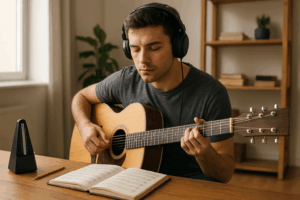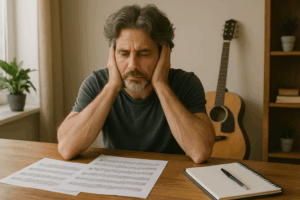Memorizing music is an essential skill for any musician. Whether you’re preparing for a performance, practicing a new piece, or simply trying to become more proficient in your playing, learning to play music by heart can make a huge difference in your musical journey. Memorizing music helps improve your understanding of the piece, allows you to focus on expression and interpretation, and boosts your confidence. In this article, we’ll explore effective strategies for memorizing music and tips for doing it efficiently.
1. Understand the Music First
Before you start memorizing a piece, it’s important to fully understand the music. This means analyzing the structure, rhythm, harmony, and melody. The more familiar you are with the music, the easier it will be to memorize.
How to Build a Strong Understanding:
- Break Down the Piece: Start by analyzing the piece section by section. Look for recurring themes, motifs, and patterns. Understanding the structure of the music will make it easier to remember.
- Focus on Key Signatures and Time Signatures: Knowing the key and time signatures will help you anticipate the musical landscape, making it easier to recognize and memorize the notes and rhythms.
- Study the Dynamics and Articulations: Pay attention to the dynamics (louds and softs) and articulations (staccato, legato, etc.). These details not only help in memorization but also improve your performance and expression.
By thoroughly understanding the music, you’ll find it much easier to recall and memorize the piece.
2. Start Slow and Build Gradually
One of the most effective ways to memorize music is by starting slow and gradually increasing speed. Rushing through a piece can lead to mistakes and hinder the memorization process.
How to Memorize Slowly:
- Practice at a Comfortable Tempo: Begin playing the piece at a slower tempo than normal. This will give you more time to focus on each note and phrase.
- Focus on Small Sections: Break the music into small, manageable sections. Memorize a few measures at a time before moving on to the next section.
- Use a Metronome: A metronome can help keep you on track and ensure that you’re practicing at a consistent tempo. Start slow, then gradually increase the speed as you become more comfortable with the music.
Taking your time and building gradually will help you solidify your memory of the music without feeling rushed.
3. Use Repetition and Consistency
Repetition is key to memorizing any piece of music. The more times you play a section, the stronger your memory will become. Consistency is also essential—short, frequent practice sessions are more effective than long, irregular ones.
How to Use Repetition Effectively:
- Repeat Sections Daily: Commit to practicing a section of the piece several times a day. Repetition helps to ingrain the notes and rhythms into your memory.
- Play from Memory: As soon as you start feeling confident with a section, try playing it from memory. This will test your recall and help reinforce your memory of the music.
- Focus on Difficult Sections: If there’s a section you’re struggling with, dedicate extra time to practicing it. Isolate the problematic measures and repeat them until they’re fully memorized.
The more you repeat the music, the more automatic it will become, and the easier it will be to recall from memory.
4. Visualize the Music
Visualization is a powerful technique used by many musicians to improve memory. By mentally rehearsing the music, you can reinforce your memory without actually touching your instrument.
How to Visualize Your Music:
- Close Your Eyes and Imagine Playing: Away from your instrument, close your eyes and mentally walk through the piece. Imagine the notes, rhythms, and fingerings as clearly as possible.
- Visualize the Sheet Music: Another technique is to visualize the sheet music in your mind. Picture the notes and the layout of the staves as you “play” the music mentally.
- See Your Fingers Moving: Visualizing the finger movements on your instrument can also help solidify the memorization process. Try to picture the movements your fingers will make and how you will transition between notes.
Visualization strengthens neural connections, making it easier to remember the music when you’re playing it for real.
5. Use the “Chunking” Method
“Chunking” is a memorization strategy that involves grouping information into smaller, manageable units. This method works well for memorizing music because most pieces are made up of repeating patterns and themes.
How to Use Chunking in Music:
- Group Phrases or Sections: Instead of memorizing individual notes, break the piece into larger sections, such as musical phrases or thematic motifs. Once you’ve memorized a chunk, it’s easier to recall the rest of the music.
- Identify Repeated Patterns: Many pieces of music contain repeated patterns or motifs. Recognizing these patterns allows you to memorize them once and then apply them to other sections of the piece.
- Focus on Key Moments: Pay special attention to transitions, key changes, and dynamic shifts. Memorize these important moments in chunks so you can navigate through them with ease.
Chunking makes the process of memorization less overwhelming and helps you retain larger sections of music.
6. Apply Memory Techniques Beyond the Notes
While memorizing the notes is important, there are other elements that contribute to your overall performance, such as dynamics, articulation, and expression. Including these factors in your memorization process will make your performance more polished and well-rounded.
How to Memorize Musical Expression:
- Think About the Emotional Message: What emotions does the piece convey? Think about how the music makes you feel and how you want to communicate that to your audience.
- Work on Dynamics and Articulations: Incorporate dynamics (loud and soft) and articulations (such as staccato or legato) as part of your memory. These nuances will make your performance more expressive and engaging.
- Use Imagery: Associate certain sections of the music with images or words that reflect the mood or meaning of the music. This will help trigger your memory and improve the overall interpretation.
Including these elements in your memorization process makes the music more personal and helps you recall it more fully.
7. Test Yourself Regularly
Once you’ve started to memorize a piece, it’s important to test yourself regularly to see how well you’ve internalized it. This will help you identify areas that need more practice and give you the confidence to perform from memory.
How to Test Your Memory:
- Play Without Sheet Music: As you practice, challenge yourself to play sections of the music without the sheet music in front of you. If you struggle with a section, go back to the sheet music and work on it until you can play it from memory.
- Perform for Others: Performing for friends, family, or even just recording yourself can help you test your memory under “real” conditions. It will also give you the chance to see how well you handle the pressure of performing from memory.
- Go Over the Entire Piece: As you get closer to memorizing the entire piece, try playing it in its entirety without looking at the music. Regularly playing through the piece will reinforce your memory and prepare you for a full performance.
Testing yourself ensures that the music is deeply ingrained in your memory and ready for performance.



